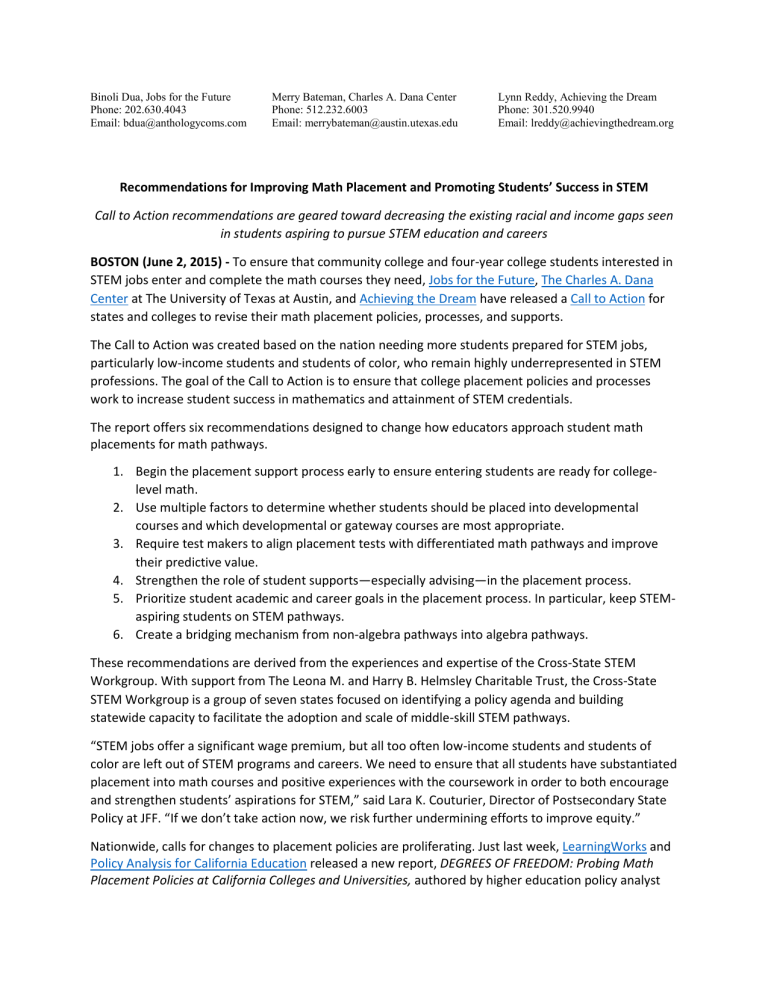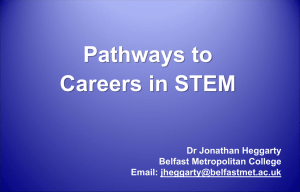Print Version

Binoli Dua, Jobs for the Future
Phone: 202.630.4043
Email: bdua@anthologycoms.com
Merry Bateman, Charles A. Dana Center
Phone: 512.232.6003
Email: merrybateman@austin.utexas.edu
Lynn Reddy, Achieving the Dream
Phone: 301.520.9940
Email: lreddy@achievingthedream.org
Recommendations for Improving Math Placement and Promoting Students’ Success in STEM
Call to Action recommendations are geared toward decreasing the existing racial and income gaps seen in students aspiring to pursue STEM education and careers
BOSTON (June 2, 2015) - To ensure that community college and four-year college students interested in
STEM jobs enter and complete the math courses they need, Jobs for the Future , The Charles A. Dana
Center at The University of Texas at Austin, and Achieving the Dream have released a Call to Action for states and colleges to revise their math placement policies, processes, and supports.
The Call to Action was created based on the nation needing more students prepared for STEM jobs, particularly low-income students and students of color, who remain highly underrepresented in STEM professions. The goal of the Call to Action is to ensure that college placement policies and processes work to increase student success in mathematics and attainment of STEM credentials.
The report offers six recommendations designed to change how educators approach student math placements for math pathways.
1.
Begin the placement support process early to ensure entering students are ready for collegelevel math.
2.
Use multiple factors to determine whether students should be placed into developmental courses and which developmental or gateway courses are most appropriate.
3.
Require test makers to align placement tests with differentiated math pathways and improve their predictive value.
4.
Strengthen the role of student supports—especially advising—in the placement process.
5.
Prioritize student academic and career goals in the placement process. In particular, keep STEMaspiring students on STEM pathways.
6.
Create a bridging mechanism from non-algebra pathways into algebra pathways.
These recommendations are derived from the experiences and expertise of the Cross-State STEM
Workgroup. With support from The Leona M. and Harry B. Helmsley Charitable Trust, the Cross-State
STEM Workgroup is a group of seven states focused on identifying a policy agenda and building statewide capacity to facilitate the adoption and scale of middle-skill STEM pathways.
“STEM jobs offer a significant wage premium, but all too often low-income students and students of color are left out of STEM programs and careers. We need to ensure that all students have substantiated placement into math courses and positive experiences with the coursework in order to both encourage and strengthen students’ aspirations for STEM,” said Lara K. Couturier, Director of Postsecondary State
Policy at JFF. “If we don’t take action now, we risk further undermining efforts to improve equity.”
Nationwide, calls for changes to placement policies are proliferating. Just last week, LearningWorks and
Policy Analysis for California Education released a new report, DEGREES OF FREEDOM: Probing Math
Placement Policies at California Colleges and Universities, authored by higher education policy analyst
Pamela Burdman . In the report, Burdman describes the many limitations inherent in math placement exams, and asks whether those exams unfairly send the majority of community college students to remedial math courses, deterring them from completing a degree. Burdman’s report reinforces many of the Call to Action’s recommendations, including the need to incorporate high school measures into placement decisions, and take career and program interests into account when placing students.
The Call to Action recommendations draw on promising results from several differentiated math pathways models, including those supported by the Dana Center’s New Mathways Project, an evidencebased redesign of college math courses and sequences designed to successfully move students through both developmental and college-level math in no more than one year.
“Success in mathematics is a key momentum point for students, especially those in STEM programs. A growing body of evidence indicates students are much more likely to achieve this milestone through accelerated, rigorous math pathways with content that is relevant to their intended program of study.
We should enable broader access to math pathways by creating a well-supported placement process that accounts for students’ goals, prior academic experiences, attitudes, as well as skills in different mathematical content areas,” said Jenna Cullinane, Strategic Policy Lead for Higher Education at the
Dana Center.
The full Call to Action is available here: http://www.jff.org/publications/call-action-improve-mathplacement-policies-and-processes
Jobs for the Future works with our partners to design and drive the adoption of education and career pathways leading from college readiness to career advancement for those struggling to succeed in today’s economy. Across the country, we work to improve the pathways leading from high school to college to family-supporting careers. Our work aligns education and training to ensure that employers have access to a skilled workforce. www.jff.org
The Charles A. Dana Center at The University of Texas at Austin works with our nation’s education systems to ensure that every student leaves school prepared for success in postsecondary education and the contemporary workplace. Our work, based on research and two decades of experience, focuses on K–
16 mathematics and science education with an emphasis on strategies for improving student engagement, motivation, persistence, and achievement. We develop innovative curricula, tools, protocols, and instructional supports and deliver powerful instructional and leadership development.
Achieving the Dream, Inc. is a national nonprofit that is dedicated to helping more community college students, particularly low-income students and students of color, stay in school and earn a college certificate or degree. Evidence-based, student-centered, and built on the values of equity and excellence,
Achieving the Dream is closing achievement gaps and accelerating student success nationwide by: 1) guiding evidence-based institutional improvement, 2) leading policy change, 3) generating knowledge, and 4) engaging the public. Conceived as an initiative in 2004 by Lumina Foundation and seven founding partner organizations, today, Achieving the Dream is leading the most comprehensive non-governmental reform network for student success in higher education history. With over 200 institutions, more than 100 coaches and advisors, and 15 state policy teams—working throughout 34 states and the District of
Columbia—the Achieving the Dream National Reform Network helps nearly 4 million community college students have a better chance of realizing greater economic opportunity and achieving their dreams.






